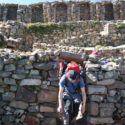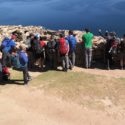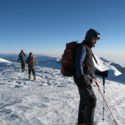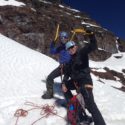On 1 June 2015 a group of 14 intrepid adventurists left the UK bound for the high mountains of the Bolivian Altiplano. Flying via Miami we eventually touched down in La Paz (4000m) after around 15 hours in the air.
This Army Mountaineering Association (AMA) Expedition had an ambitious plan to scale a number of extremely high altitude peaks over the next four weeks, including the second highest peak in Bolivia, Illimani (6438m). The expedition team had been pulled together from across Force Troop Command (FTC), and included 3 Reservists from 205 Fd Hosp, 212 Fd Hosp and CVHQ RA.
After spending a couple of days in La Paz to shake out our admin and to acclimatise to the rareified air, the team headed off to Copacabana. From here we set sail for Isla del Sol, the largest Island in Lake Titicaca.
This phase of the expedition provided a cultural introduction to the ancient Inca and Aymara cultures, which were once indigenous to this region. The Island museum related how the French Sub Aqua pioneer, Jacques Cousteau, had explored the turquoise waters around the Island to look for a sunken Inca City.
We soon left Isla del Sol behind as we headed towards the Bolivian Condirri and the first of our many mountaineering objectives.
Our first high point was Point Austria (5300m) which provided stunning views across the Condirri valleys and attuned our bodies to the rigours of high altitude climbing.
The next morning the focus was ice axe and crampon training on the glacier, which stood white and glistening at the top of the valley, about an hour’s walk from base camp. After demonstrating some level of competence to our Guides that we could move around safely on the ice without endangering them or ourselves we retreated back to base camp.
The next few mornings saw us up long before dawn as we prepared for our Alpine starts, designed to get us up onto the mountain tops for sunrise and to allow us enough time to beat a hasty retreat down the glacier before it became `peligroso` (dangerous) a word that would regularly, and unnervingly, crop up in our Guides vocabularly.
Having conquered the austere Piramide Blanca (5230m), the beautiful, but unforgiving, Pequeno Alpamayo (5370m), and the chossy and friable aspects of Illusion (5330m), we returned to the bustle of La Paz to take stock and reorganize for the next high altitude challenge, Huayna Potosi (6088m).
For this challenge we traded our tents for Alpine Refugios (huts) which would act as staging posts for our assault on the mountain. The spacious layout and style of the Base Camp was in stark contrast to the High Camp Refugio with its cramped bunkbeds and limited dining space.
Our 02.30 start, delayed by an hour due to the high winds whistling around the Refugio. Once more we hear the word `peligroso`. Finally the winds die down and we emerge into the chill of the pre-dawn air. Steadily we climb the steep sided slopes of the mountain, our lungs gasping to take in the thin air. Our head torches pierce through the darkness to light our shuffling gait. Finally we are on top of Potosi and from this magnificent viewpoint we can cast our gaze onto the final challenge of the expedition – Illimani.
Once again we head back to La Paz for a brief respite. A day later and we head out along an unsealed and corrugated road which clings to the hillside like a ribbon wound around a paper package. We arrive at Pinaya the end of the road, but also the starting point for our climb. This is the highest and toughest climb yet, with high camp pitched at 5450m.
Once again we are in tents and the cold seeps into our bones as the sun dips below the distant horizon. Another early start and a 10 hour day ahead. Once again the gradient lies unrelentingly upwards and we struggle onwards with the now familiar shuffling gait. We wind our way through the myriad of crevasses that crisscross the glaciated aspect of the mountain. The summit appears both close and far away, a strange paradox, a trick of the light or a skewed perception of a mind doctored by altitude. Finally the gradient levels out and the true summit is a mere few footfalls away. In the far distance we can see Sajama (6549m), a higher but less interesting climb, taunting, beckoning….maybe one day we will return.
S Sgt Stuart Low
205 Fd Hosp




